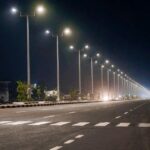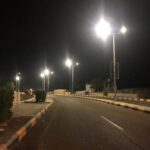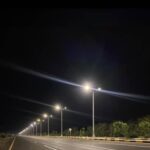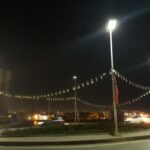Semi integrated solar street lights have emerged as an innovative and sustainable solution to illuminate our public spaces. The term “semi-integrated” refers to the configuration of the system, which incorporates some level of integration between the solar panel, battery, and light fixture. In this design, the solar panel is typically separate from the light fixture but connected to it through a cable. The solar panel is positioned in a way that allows it to receive maximum sunlight exposure during the day for efficient charging of the battery.

A semi integrated solar street light
Features of a semi integrated solar street light
The working principle of a semi integrated solar street light is based on the utilization of solar energy to generate electricity and provide lighting in outdoor areas. What are the components of these innovative light systems?
-
Solar panel
When sunlight falls on the solar panel, it absorbs the energy and converts it into electrical energy through the photovoltaic (PV) effect. The solar panel is composed of multiple solar cells made of semiconductor materials such as silicon. These cells contain layers that create an electric field when exposed to sunlight.
-
Battery
The generated electrical energy is then stored in a rechargeable battery, typically a lithium-ion or lead-acid battery. The battery acts as an energy reservoir, storing the electricity during the daytime when the solar panel produces surplus energy. This stored energy is later used to power the street light during the night or when there is insufficient sunlight.
-
Light fixture
To provide illumination, the energy from the battery is supplied to the light source, which is usually an energy-efficient LED (Light Emitting Diode) lamp. LEDs consume significantly less power compared to traditional lighting technologies, making them ideal for solar street lights. The LED light emits bright and focused illumination, providing adequate lighting for streets, pathways, or other outdoor areas.
-
Controller
To control the operation of the solar street light, an intelligent controller is employed. The controller regulates the charging and discharging of the battery, ensuring efficient energy management. It also includes features like light sensors to automatically switch the light on at dusk and off at dawn, as well as motion sensors to activate the light when movement is detected nearby.
-
Sensors
Light sensors detect ambient light levels, enabling automatic switching on/off of the street light to conserve energy and extend battery life. Motion sensors detect nearby movement, triggering increased brightness for improved safety while minimizing energy wastage. Battery level sensors monitor the charge level, optimizing charging and discharging to prolong battery life.
Benefits of semi integrated solar street light
A Semi integrated solar street light offers several benefits compared to traditional street lighting solutions. What are some of these advantages?
1. Energy efficiency
One of the key advantages of semi integrated solar street lights is their ability to convert solar energy into electrical power with exceptional efficiency. These lights utilize high-quality solar panels to capture sunlight and convert it into electricity, which is then stored in a built-in battery system. This stored energy is intelligently utilized to illuminate the streets during the night, ensuring efficient and reliable lighting.
The energy-efficient nature of semi integrated solar street lights offers several benefits. Firstly, it significantly reduces electricity consumption, leading to substantial cost savings. Since solar energy is a renewable resource, it eliminates the need for traditional electricity, which is often generated from non-renewable sources and contributes to greenhouse gas emissions.
2. Cost saving
With semi integrated solar street lights, the primary expense lies in the initial installation. Once installed, these lights require minimal maintenance, as they rely on renewable energy and have fewer components compared to traditional street lights. As a result, ongoing maintenance costs are significantly lower.
Since semi integrated solar street lights are not dependent on the grid, there are no electricity bills to pay. This eliminates the continuous expense of purchasing electricity, allowing for substantial savings over time. Furthermore, these lights often come equipped with intelligent lighting controls, enabling them to adjust their brightness based on ambient conditions. This feature not only ensures optimal lighting but also contributes to energy savings.
3. Environmental friendly
The use of solar energy eliminates the production of harmful byproducts associated with conventional energy generation methods. With no burning of fossil fuels, semi integrated solar street lights significantly reduce air pollution and mitigate the release of toxic gases into the atmosphere. This positive environmental impact helps to combat climate change and improve overall air quality, fostering healthier and more sustainable communities.
Additionally, semi integrated solar street lights operate autonomously and do not require extensive wiring or underground infrastructure. This aspect minimizes the disruption of natural habitats during installation and reduces the need for land excavation. By preserving the existing ecosystem, these lights help to maintain biodiversity and conserve valuable natural resources.
4. Easy installation
To install a semi integrated solar street light, simply secure the pole to the ground and attach the light fixture. As the solar panels and batteries are already integrated into the pole, there is no need to connect separate components or perform complex wiring. This user-friendly design makes the installation process quick and straightforward, even for those without specialized technical knowledge.
The ease of installation of semi integrated solar street lights not only saves time but also reduces installation costs. With simplified installation steps, fewer resources and labor are required, resulting in overall cost savings for the project. Additionally, the straightforward installation process minimizes the chances of errors or complications, ensuring a smooth and efficient setup.
5. Scalability and expandability
Scalability refers to the ability of semi integrated solar street lights to be easily scaled up or down based on the lighting requirements of a particular area. Whether it is a small residential street or a large commercial complex, these lights can be adjusted to meet the specific illumination needs of the environment. With their modular design and flexible configurations, additional lighting units can be effortlessly added or removed as the situation demands.
The expandability aspect of semi integrated solar street lights focuses on their capacity to accommodate future advancements and technological improvements. As solar energy technology continues to evolve, these lights can be readily upgraded with more efficient solar panels, advanced batteries, or intelligent control systems. This adaptability ensures that the lighting system remains up-to-date and can leverage the latest advancements in solar technology.
Semi integrated solar street light
Future development of semi integrated solar street light
In the future, we can expect several exciting developments in these solar street lights. These advancements aim to improve their efficiency, functionality, and overall performance. Here are some potential future developments:
1. Higher Efficiency Solar Panels
Future semi integrated solar street lights will likely incorporate more advanced solar panel technologies. These could include the use of multi-junction solar cells, which can capture a broader spectrum of sunlight and increase the overall conversion efficiency. Additionally, the integration of anti-reflective coatings and solar concentrators may further enhance the panels’ efficiency.
2. Energy Storage Innovations
To ensure reliable operation during periods of low sunlight or extended nights, future semi integrated solar street lights may feature advanced energy storage solutions. This could involve the integration of high-capacity lithium-ion or solid-state batteries, which offer improved energy density, longer lifespan, and faster charging capabilities. Additionally, emerging technologies such as flow batteries or supercapacitors could also be explored for their potential in energy storage.
3. Intelligent Control Systems
The future development of semi integrated solar street lights will likely focus on intelligent control systems. These systems can optimize the light output based on real-time conditions, such as ambient light levels and traffic patterns. Implementing smart algorithms and sensors will enable automatic dimming or brightening of the lights, resulting in energy savings and increased efficiency.
4. Wireless Connectivity and Monitoring
To enable remote management and monitoring, future semi integrated solar street lights may incorporate wireless connectivity. This would allow for centralized control, real-time performance monitoring, and timely maintenance. By harnessing data analytics, operators can optimize energy usage, detect faults or failures, and proactively address any issues.
5. Enhanced Durability and Weather Resistance
Street lights are exposed to various weather conditions, so future developments will likely focus on improving their durability and weather resistance. This could involve the use of robust materials, corrosion-resistant coatings, and reinforced designs to ensure that the lights can withstand harsh environments and continue operating reliably.
6. Integration of Smart City Features
As cities become smarter, future semi integrated solar street lights may integrate additional functionalities to support smart city initiatives. These could include features like integrated sensors for air quality monitoring, traffic monitoring, or even wireless charging capabilities for electric vehicles.
Tips to maintain a semi integrated solar street light
What should you do to increase the lifespan of your solar street light?
- Regularly clean the solar panels: Dust, dirt, and debris can accumulate on the solar panels, reducing their efficiency.
- Inspect the battery: Check the battery regularly for any signs of corrosion, leakage, or damage.
- Inspect the wiring and connections: Periodically inspect the wiring and connections for any loose or damaged parts.
- Check the controller and sensors: Verify that the controller and sensors are functioning correctly.
- Monitor battery performance: Keep track of the battery’s performance and capacity.
- Trim vegetation: Ensure that there is no overgrown vegetation blocking sunlight from reaching the solar panels or obstructing the light’s path.
Semi integrated solar street light
Conclusion
The utilization of semi integrated solar street lights presents a compelling solution for enhancing street lighting systems. These lights combine the advantages of solar power and an integrated design, resulting in a cost-effective and environmentally conscious lighting option. Semi integrated solar street lights offer immense potential for widespread implementation, playing a crucial role in our pursuit of a more sustainable future. Do you have any questions on semi integrated solar street lights? Contact us.


















